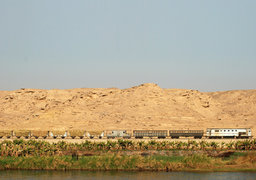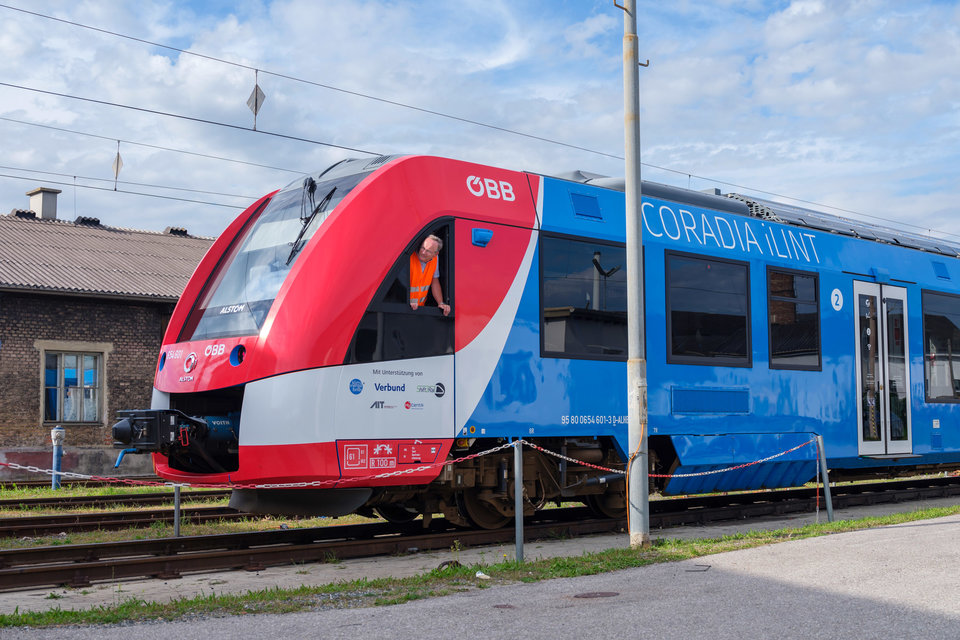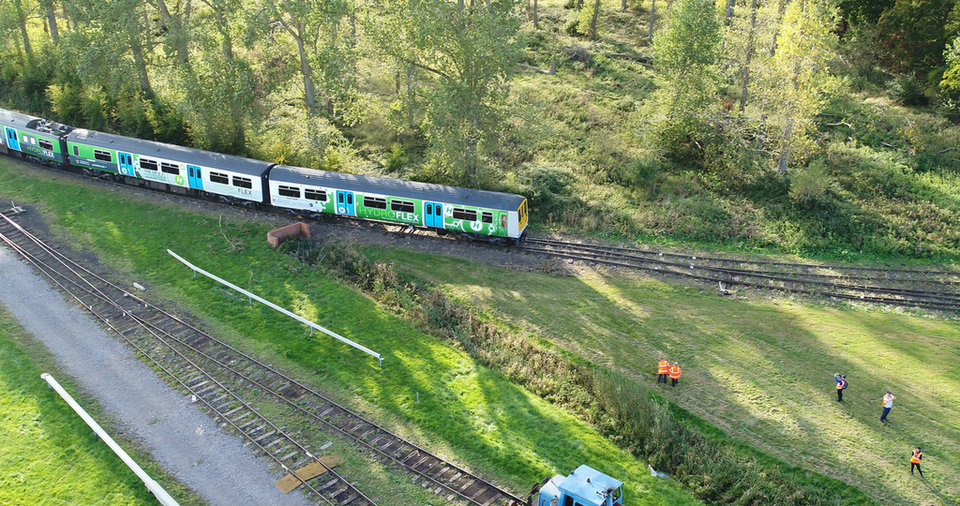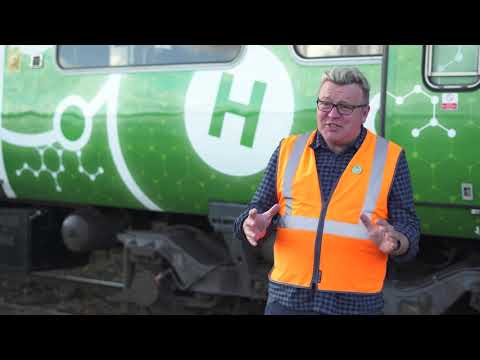Fuels
Next stop, hydrogen? The future of train fuels
Pyramid schemes: a look into Egypt’s megaprojects
Climate change and emissions reduction are topics high on the agenda for the rail industry. As companies continue to seek more sustainable fuel options, Frankie Youd explores the potential of hydrogen as a train fuel.
W
ith 2021 being named the European Year of Rail, all eyes are on the industry when it comes to innovation, sustainability initiatives and new technology.
Rail has been recognised as one of the cleanest, greenest modes of transport. Data from the Office of Rail and Road, published in its report 'Rail Emissions 2019-2020', shows that, for passenger trains, diesel usage increased by 1.5% compared to 2018-2019, but the resulting CO2e emissions for passenger trains have fallen to 35.1g CO2e per passenger kilometre. This is the lowest level recorded since the comparative data series started in 2011-2012.
Although rail has a less harmful impact on the environment than many other modes of transport, the industry is constantly striving towards alternative fuels that could help reduce its environmental impact. Some companies have opted for battery-powered engines as a cleaner alternative, while others are turning to hydrogen to fuel their trains.
Hydrogen fuel can be produced through several methods. The most commonly used methods today are natural gas reforming (a thermal process) and electrolysis of water, which sees electricity running through water to separate the hydrogen and oxygen atoms. The electricity used can be generated by wind, solar and hydro sources.
Brightline senior vice president, corporate affairs, Ben Porritt


Alstom’s hydrogen-powered Coria iLint trains are used in Germany, Italy, France and Austria. Credit: Alstom
The world’s first hydrogen train
The world’s first passenger train powered by hydrogen fuel cells was produced by Alstom. Named Coradia iLint, this zero-emission train also emits low noise levels due to the exhaust being only steam and condensed water.
The train was first showcased back in 2016 at InnoTrans in Berlin and entered commercial service in Germany in 2018. Following on from successful operations in Germany, Alstom received several orders for its hydrogen-powered locomotives from Italy, France and Austria.
In a press release, Jörg Nikutta, Alstom Transport Deutschland managing director for Germany and Austria, commented: "Our two pre-series trains of the Coradia iLint have proven over the past year and a half that fuel cell technology can be used successfully in daily passenger service.”
The electricity required for the running of the on-board systems is supplied via a fuel cell, which generates energy by combining the hydrogen stored on the train’s roof with oxygen in the air.
The Coradia iLint can carry up to 150 seated passengers and 150 standing passengers and can reach a range of up to 1,000km at a maximum speed of 140km/h.
Hydrogen power: a first for the UK
The UK’s first hydrogen-powered train, HydroFLEX, was developed by the University of Birmingham’s Centre for Railway Research and Education and rolling stock solutions provider Porterbrook and launched in 2019.
The HydroFLEX train has been developed from a Class 319 train – a class first built in 1987. Porterbrook collaborated with Northern to fit the train with hydrogen fuel tanks, a fuel cell and battery pack to allow the train to operate with zero carbon emissions.
The fuel cell unit, powered by hydrogen, converts the mixture of hydrogen and oxygen to generate electricity of up to 100kW with water being the only by-product. HydroFLEX is also fitted with two lithium-ion battery packs, which allow the electrical energy to be stored, making it the world’s first bi-mode electric hydrogen train.

The HydroFLEX train during line testing.
HydroFLEX carried out its first successful mainline test at the end of last year. During the first series of trials the train – dubbed HydroFLEX one - completed a 25-mile round trip through Warwickshire and Worcestershire.
“When we originally designed HydroFLEX, it was designed with the mindset that they would go on the mainline," explains Dr Stuart Hillmansen of the Birmingham Centre for Railway Research and Education. "To get it on the mainline, you must prove that it's compliant with all the standards and regulations that are required to run vehicles on the mainline. We went through that process with Porterbrook, and we had funding from them as well as Innovate UK."
The train completed the route of the 25-mile journey three times. “It was very much a demonstrator to show that the train could be used on the mainline and is compatible with the existing infrastructure," Hillmansen says. “It was a success; the train ran very well during the three tests and performed pretty much as expected. We learned a lot from the engineering and all the data that we gathered was a huge input into the future design as well.”
Following on from the successful testing of HydroFLEX one, development of HydroFLEX two has been carried out with the help of further funding from Innovate UK. The funding has enabled the team to develop a design which allows the fuel cell and battery system to be more integrated to the overall design of the train.
HydroFLEX one had all equipment installed inside one of the central vehicles, limiting its ability to carry passengers. It also limited the amount of power it could produce, with the train hitting a maximum speed of 50mph.
“We need a lot more power installed in HydroFLEX two,” Hillmansen said. “The current project is all about designing a power system that has a fuel cell power system, the housing storage system, the control system and the battery system integrated into the train system to provide an increased level of power, and therefore performance of the train.”
The HydroFLEX team talks about the train’s development and testing.
Why hydrogen?
The use of hydrogen as an alternative rail fuel brings many potential benefits, the most noticeable being that it is a clean energy source that supports zero-carbon strategies. Hydrogen fuel cell technology also provides a more powerful and efficient energy output compared to fossil fuels.
The team behind HydroFLEX chose hydrogen because it is a fully mobile fuel which can be carried around on the train, as well as being a renewable energy source.
“Hydrogen allows us to get the range and performance and then importantly, you can create hydrogen through electrolysis, that's a key step really,” explains Hillmansen.
“The national grid sector wants to decarbonise by 205; it is already hitting massive targets. What we can do is take grid electricity, which is becoming decarbonised and put it through an electrolyser to make hydrogen, which can then be used to fuel the trains.”
In some rural areas you may have four trains a day, or a train every two hours. You'd never be able to cover the cost of electrification on that part of the network.
Alongside hydrogen, many rail companies have also been exploring the use of battery power to power trains via renewable electricity. However, this technology comes with some setbacks, as batteries aren’t currently able to store as much energy as is required to power a train.
Another setback presents itself in terms of location, according to Hillmansen. “A common criticism is ‘Why don't you just use the electricity directly and then electrify the railway lines?’,” he says. “Yes, that makes sense because you don't waste electricity in the electrolysis process. However, on many parts of our railway there isn't the right frequency of service to justify electrification.
“In some rural areas you may have four trains a day, or a train every two hours. You'd never be able to cover the cost of electrification on that part of the network. So that's where we see hydrogen as having a tremendous potential to solve that decarbonisation problem for those routes.”
As more companies follow suit with the development of hydrogen trains, the industry may be on track for an increasingly cleaner future.
Main image: Alstom’s Coradia iLint was the world’s first passenger train powered by hydrogen fuel cell. Credit: Alstom
